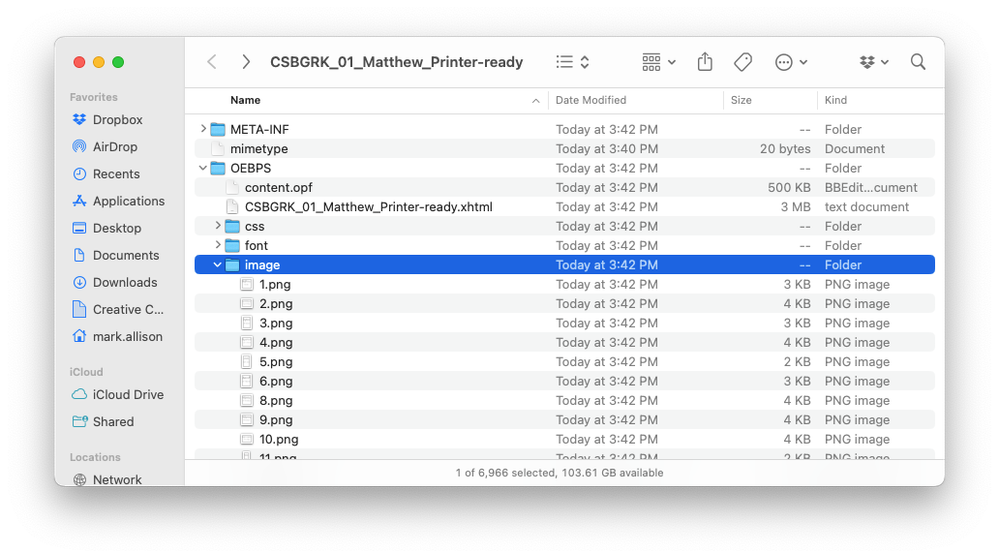- Home
- InDesign
- Discussions
- How to export over 2,000 pages where every page is...
- How to export over 2,000 pages where every page is...
How to export over 2,000 pages where every page is a table with hundreds of cells
Copy link to clipboard
Copied
I have a huge document in InDesign (it's a Greek/English Interlinear New Testament) that I'm trying to export as a reflowable ePub. The problem is that every page is a table, with hundreds of cells. When I try to export it as a reflowable ePub, it exports the contents of every cell as an image.
Does anyone know how I can export this (it doesn't have to be an ePub) and maintain the text info? It's driving me nuts! Thanks in advance for any help.
Copy link to clipboard
Copied
Reflowable EPUB does not typically do any kind of image conversion such as you note — that's a hallmark of fixed-layout EPUB, FXL Are you quite sure you're exporting to Reflowable EPUB?
There are export options wherein graphical elements can be processed into (most commonly) flattened graphics — for example, if you have a photo with a couple of annotations and arrows added in ID, it will not export in that form with any accuracy. If you specify that the contents of that frame are to be rasterized, ID will do just that, turn the whole image content into a single raster file. Something like that might be happening with your tables.
So, assuming you are exporting to reflowable — is the content of your document 100% text, even in the table cells? Or have you placed elements as graphical ones in those cells?
All said, though, if you want a digital, e-book version... PDF is probably a better solution in every way.
Copy link to clipboard
Copied
I may be wrong but I seem to remember early versions of InDesign doing this (or maybe that was something else???). Regardless, what version are you using and what are your export settings?
Copy link to clipboard
Copied
I'm using the latest version of InDesign (18.5). Regardless of my Reflowable ePub export settings I only get png images.
Copy link to clipboard
Copied
Something is wrong. Reflowable EPUB basically does not create graphical versions of content as FXL does, not unless the contents are set up specifically to export that way (and it's tricky).
I think we're going to have to see your EPUB export settings, and a sample of the document. All I can think is that your table cells might be set up with graphic frames elements.
Again, are you using ANY graphics within the document? A background for the table cells, perhaps? Have you set any kind of object export overrride on any of the table frames?
Copy link to clipboard
Copied
Here's a copy of the first section of the project. Thanks for taking the time to look at this!https://www.dropbox.com/scl/fi/5cf762s9ioox8ua860rn1/CSBGRK_01_Matthew_Printer-ready.indd?rlkey=aq8e...
Copy link to clipboard
Copied
Okay. Uh, holy cow, to coin a phrase, that's an enormous amount of work, and I salute both the effort and the accomplishment. But that layout format is never, ever going to export to a liquid e-book format. If I may show a quick snip:
That's not in any way "a table" except in the loosest sense. While every text box appears to be nothing but text, with the rule in between, I can't think of an export method that could preserve that "mosaic" structure (again, forgive the slight pun there). ID converting each element to a graphic, which is something I've never seen it do, is its best compromise.
I would say that PDF is the only electronic format that could handle this. That and FXL EPUB, which is normally an obsolete format to be avoided, but it would just produce much the same effect as the PDF with a far less consistent or reliable result.
Impressive piece of work, though. But it's for printing, the effectively-"printing" of PDF or, I guess, carving on stone. 🙂
Copy link to clipboard
Copied
Replying on my phone so can't check right now - are those Tables inside TFs placed as InLine Objects in the Story?
Copy link to clipboard
Copied
@James Gifford—NitroPress so how this file should be converted in order for it to be readable by apps?
Re-thread top Greek parts as a separate Story then bottom parts as 2nd Story?
Or mix them together?
I would have to add few extra rules for my ID-Tasker, but it's not a problem.
Copy link to clipboard
Copied
I need to have each Greek word followed immediately by the English words.
Copy link to clipboard
Copied
If link to your example file is still working - something will be ready by tomorrow.
Copy link to clipboard
Copied
I have no idea how to make this overall book layout match both a precise visual need (as the OP has it laid out) and export to a clean and simple liquid e-book format... much less one that would preserve accessibility, or even, possibly, search and TOC. Each word group more or less necessarily has to be its own text flow, and at best there would be two text flows in parallel (although I'm scratching my head on how to make that happen).
This is just a rare example where the physical layout has to be preseved and there's no route to liquid e-text, I think. FXL, maybe; PDF, definitely; reflowable/liquid... I think it would be into Nobel Prize territory to solve. 🙂
Copy link to clipboard
Copied
I already have a plan in my head - and it doesn't look so complicated... It's just a bunch of TFs with Tables inside...
Copy link to clipboard
Copied
Okay. Be sure to look at the sample file, though — it also needs to include the line numbers, a parallel summary sidebar and similar elements common to scriptural reference. That is, it's not just two parallel texts. I'll go make some popcorn. 😄
Copy link to clipboard
Copied
Not a problem - as long as it doesn't need human decision - too much - shouldn't be a problem.
My ID-Tasker is extremely powerful tool.
Copy link to clipboard
Copied
How is your popcorn?
Here is 1st step - nothing special, functionality already present in the ID-Tasker:
To speed up testing - I had to remove all but 3 pages and 2nd layer - so only 424 objects left - from more than 15k - or 35k - don't remember right now - but my laptop was dying.
All InLine TFs are sorted by Page + PosY + PosX - so everything is nicely ordered by rows.
Now, I need to create a rule that will extract / split Table into separate TFs - and place them in exactly the same place as Cells - then thread them together but rule for that is already done.
Copy link to clipboard
Copied
Same thing - structure - but from the Text perspective:
So 90% of the job - finding all objects and getting them in order - solved.
Now only threading part left...
But just in case - is my idea right ?
Create TFs for top and bottom parts - then thread them together ?
Copy link to clipboard
Copied
Yes! That's looking great. BTW, I don't need any of the info in the column on the right. Just the Greek/English words on the left in the proper order.
Copy link to clipboard
Copied
Yeah, I thought so.
It's just a leftover - as it was on the same layer as the Main text.
Copy link to clipboard
Copied
I'm not sure any of this is going to solve the basic problem, that of ID wanting to convert each itty-bitty text element to an image. And I am not sure two separate text threads serves any useful purpose other than for search, as they will no longer be associated with the companion word.
Just, IMVHO, there are too many conflicting needs to achieve the desired goal (a truly text-based EPUB) while preserving the many special needs of the word associations and order... other than "just doing it all a different way." But I'm not out of popcorn yet, so carry on.
Copy link to clipboard
Copied
2nd step - TFs from the 1st Paragraph Duplicated:
So what are you saying @James Gifford—NitroPress ?
What should be the next step - one Story with Greek mixed with English ? Or two separate Stories ?
I can go either way - if fact, my plan was to do it both ways anyway - one file with mixed Story and another file with separated Stories.
The only difference would be how those TFs are sorted and filtered before linking them together.
Copy link to clipboard
Copied
Robert, I need one story with Greek mixed with English.
Copy link to clipboard
Copied
As you wish.
Copy link to clipboard
Copied
Done: (new screenshot with modified ParaStyles so text is centered)
Took me a bit longer - shortcuts are not always the best solution...
1st Task - splits Tables into top & bottom TFs,
2nd Task - Rules should be self explanatory.
Both tasks need to be executed one after the other in BatchMode - after filters and sorting is applied - but can be 100% automated - right now I was doing it manually.
Copy link to clipboard
Copied
And here is a finall step - extraction of single Characters as TextFrames - so they can be linked together as a Story with the extracted Greek and English phrases:
Moved Shift+⬅ 1x and to a differeent layer for clarity. There is some extra formatting - that's why "2" is so much higher. Of course can be aligned if needed.
Here is a maximumm 4000% zoom:
Copy is behind and have 0.1pt stroke aligned to the centre so 0.05pt is visible.
-
- 1
- 2
Find more inspiration, events, and resources on the new Adobe Community
Explore Now









